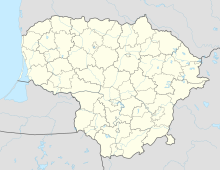| 1993 Coup of the Volunteers | |||||||
|---|---|---|---|---|---|---|---|
| |||||||
| Belligerents | |||||||
|
|
| ||||||
| Commanders and leaders | |||||||
| Audrius Butkevičius |
Jonas Maskvytis Alvydas Pangonis | ||||||
| Strength | |||||||
| ? | About 150 men | ||||||
| Casualties and losses | |||||||
| 1 civilian dead | |||||||
Location of Riogliškiai within Lithuania | |||||||
The Coup of the Volunteers (Lithuanian: Pakaunės savanorių maištas) was a stand-off that occurred in summer 1993 in Lithuania near Kaunas between a group of about 150 men from the Lithuanian National Defence Volunteer Forces (then known as Savanoriškoji krašto apsaugos tarnyba or SKAT) and the Lithuanian government. There was mutual distrust between SKAT and the newly elected leftist Democratic Labour Party of Lithuania (LDDP). Several SKAT members (usually referred to as volunteers) abandoned their posts, took their arms, and retreated to a wooded area near Kaunas in July and August 1993. The crisis escalated when the government issued an order for the volunteers to secure their weapons at designated locations in September. Interpreting the order as confiscation of their weapons, a total of about 150 armed men gathered near Riogliškiai. They expressed their mistrust and dissatisfaction with the new LDDP government and raised social and political demands. After a week long negotiations, the men agreed to return to their posts if no one would be persecuted for their role in the coup.
Although it concluded peacefully, the stand-off is one of the most controversial and little understood episodes in the early years of post-Soviet Lithuania. Sociologist Zenonas Norkus evaluated the events as a "stress test" of the Lithuanian democracy and the new relationship between the anti-communist and ex-communist elites. The anti-communists, which were now in opposition, did not use the opportunity to return to power.[1] The stand-off was followed by two related and unsolved bombings of the Bražuolė railway bridge in November 1994 (no casualties) and of a passenger car in January 1997 (SKAT officer Juras Abromavičius was killed). The events remain controversial and subject to numerous theories and conspiracies. The political right accuses Russian secret services, while the political left points to the conservatives.[2]
